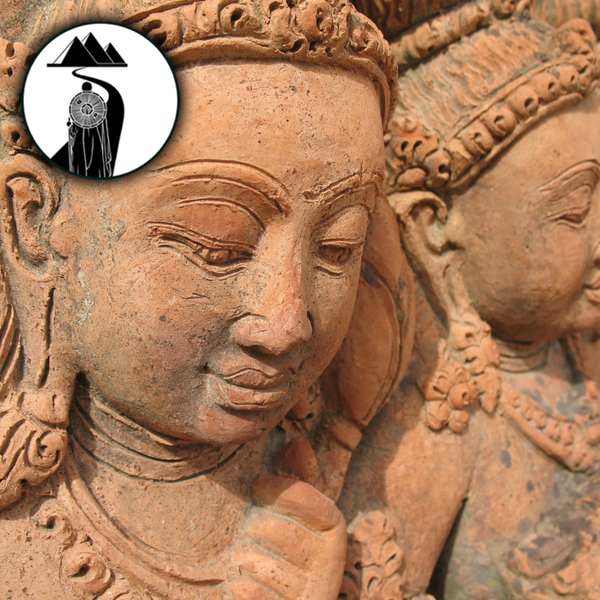Origins of Buddhism



In Search of the Gods | May 15, 2024 | Written By Sahkana Merutepiaou
In the town of Bodh Gaya, Siddhartha decided to sit under a fig tree (bodhi tree) for as long as it would take for the answers to the problem of suffering to come to him. He sat for many days, first in deep concentration to clear his mind of distractions, then in mindful meditation, opening himself up to the truth. He began, they say, to recall his previous lives and saw everything that was happening in the universe. On the full moon of May, with the rising of the morning star, Siddhartha finally understood the answer to the question of suffering, and he became the Buddha, which means "he who is awake".
It is said that Mara, the evil one, tried to prevent this great occurrence. He tried to frighten Siddhartha with storms and armies of demons, but Siddhartha remained completely calm. He then sent his three beautiful daughters to tempt him, again to no avail. He tried to trap Siddhartha in his own ego by appealing to his pride, but that, too, failed. Siddhartha, having conquered all temptations, touched the ground with one hand and asked the Earth to be his witness.
Buddha had achieved his enlightenment at age 35. He would go on to teach throughout northeast India for 45 years, When he was 80 years old, he told his friend and cousin Ananda that he would soon be leaving. In Kushinagara, not 100 miles from his homeland, he ate spoiled food and became very ill. He went into deep meditation under a grove of sala trees and died. His last words were "Impermanent are all created things; strive on with awareness", It was necessary to give the reader this background information in order to ensure understanding of this individual and to provide a basis on which to make comparisons. The life of the Buddha is interesting, and from this story, a following of over 300 million people across the globe evolved.
It is important to recognize similarities that the story of Buddha has with other practices. For instance, those who practice Christianity will be able to see a similarity of the temptations of Christ by the devil and the temptations of the Buddha by Mara, "the evil one", Although, Buddhism was introduced long before Christianity, the notion of a powerful evil being trying to prevent an enlightened being from saving humanity from ignorance and suffering remains somewhat identical. Would this comparison be considered coincidental? Millions of followers on both sides would probably say yes, but one that truly spiritual system or practice is based on an original model will not deem these similar events a coincidence. As humans, we do not create anything that is new, Whether it is a thing, philosophy or system. We only have the ability to imitate what exists already. This stands true in every aspect, regardless of how much we may choose to ignore or deny this reality.
One who researches sensitive subjects knows that the answers he seeks will not be found by reading books or surfing the internet. The true history of the world and all of its wonders can only be found by going to the source of all civilization, and, putting emotions aside, few will argue against the fact that Africa is the cradle of all mankind. Every religion, culture, language, government, etc. has its origins in the Nile and Niger Valleys, or Kemet. It was this civilization that set the standard for the rest of the world; it is the place from where the most noted philosophers throughout history came to receive their education about life, death, science, art, spirituality, astronomy and dozens of other subjects. In essence, to obtain vital truths about events that took place in ancient times, we must return to the foundation.
This is why this writer consulted with Master Naba Lamoussa Morodenibig, the only authentic Kemetic priest outside of the secret initiation camps of Africa. It must first be explained that there are many cultures in Africa that have continued the practices and values of the inhabitants of the Nile and Niger Valleys. This knowledge, once taught in the mystery schools of Kemet, has been kept intact and away from corruption; today, it is only attainable through intense secret initiations in the African bush. Many priests are produced, and they have learned the same knowledge as the priests of the Pharaonic period. It is very rare for these priests to leave the bush and, until now, a priest has never been given permission to share the knowledge with the uninitiated. This is what makes Master Naba's teachings priceless.
Many interesting facts came to the surface about Buddhism when I spoke with Master Naba. When asked about the Buddha's true origins, Master Naba said, "The truth is, for the last 2000 years, there has been a systematical process of re-writing the world's history. Because of this, people have been educated in the ways that the new system wants them to be educated. As a result, some normal parts of human history become a mystery. Before 3000 BC, there was no culture or system that did not come from the Nile Valley. At that time, many priests of different temples had a model that they were following. It was customary for them to travel throughout the world and bring the "news" ', civilization, agriculture, education, and everything that a human being can be proud of today. After doing their work at home, they would be delegated by the temples to travel and bring the news. This is how the notion of spiritual development and evolution reached every part of the world. No spiritually enlightened or intelligent person will question that. Since this happened, you see that all the Semetic cultures, Buddhism and Hinduism included, will have one thing in common, which is having their roots in Africa. The problem is, if you take Africa out of the picture, whatever God or prophet that people are talking about comes with no proof other than legends!"
The latter part of Master Naba's statement has a very profound effect on the consciousness, as the story of Buddha presented in the beginning of this text is not the only one that is believed to have happened. This applies to the majority of historic figures that represent a specific belief system; one must wonder how true these stores actually are.
"With every kind of people trying to develop some kind of nationalism, they managed to find it offensive in recognizing the facts, and it becomes a personal internal conflict for them. How will they legitimize their Gods or prophets if they cut out their roots? Historically, the Buddha story is just a legend. Buddha was really a traveler. He served the temples of Africa, and at one point he left and established himself in India, where he continued his work. Many other priests did the
same thing all over the world. If you check, you can see that the names of the Gods from Asia to Japan have something in them to remind them of Black culture. Buddha was a priest from the Nile Valley, but he was a priest as a part of a body of priests, and was not on his own." Master Naba explained.
This information may be difficult to accept by loyal Buddhists. This exclusive interview with Master Naba was done only with the purpose of bringing light to the origins and purpose of the man that is known and worshiped today as Buddha. The message that he brought is one of righteousness, and coming from the Nile Valley, it was the priest's job to inform the masses of the existence of the world of Gods. This part of Buddha's history has been deleted for reasons that are too involved to explore now.
After passing the tests of temptation, it is said that Buddha touched the ground and asked the Earth to be his witness. This is symbolic of a priest reading the Earth Energies (geomancy), and it is the oldest initiatic science known in the spiritual realm as M'TAM. By doing this, the priests were able to know the answers to any questions they had and enabled them to see the future, present and past. Communication with the Earth was done using M'TAM. If Buddha was actually a priest from Africa, this event in this story is fitting.
What temple in Africa was Buddha from? I posed this question to Master Naba. "You have to understand the particularity of a gnome. There are no two gnomes that are the same, and they are based on their approach or what kind of flavor is given to the human afterlife. All of humanity understood that life does not stop after the body dies, but the problem anses: Where do we go from there? There is a period in reincarnation that comes into play, and that is where the difference in the gnomes are reflected. What is the ultimate goal of reincarnation? The first groups of gnomes from Thebes, Bursa, Hebtaka, etc. said that because Gods are our example, we want to become like them. Life and reincarnation is another chance given to us to perfect ourselves and become Gods. There is a smaller group of gnomes that approached it differently. For them, the process of reincarnation became an infinite cycle of going through the same thing over and over. Their ultimate goal is to reach the level where you do not have to reincarnate, and, for life and reincarnation is a burden. Spiritually, these two sets of gnomes took different paths, and depending on which direction you are going, the fact is that the need to be good is still there, but the reasons why we are being good are different for each gnome. For the gnomes that saw reincarnation as a burden, when a person dies, their body is burned to secure the fact that even if you do reincarnate, it will be as something else. This is what gives us the concept that fire is an instrument of purity," Master Naba said.
Cremation is a regular funerary practice throughout many parts of Asia and in other parts of the world, but few know the logic behind the action. "Socially, burning a dead body makes a human more humble. It is clear that from these two sets of gnomes, spirituality went on. Their messages may look alike, but the ultimate goal is different. If we want to pinpoint the exact gnome Buddha came from, that would only be speculation, and we don't like to speculate in the spiritual domain. Buddha changed life for the better in the East, but this does not change the fact that he was a priest from the Nile Valley," Master Naba said with conviction.
The knowledge on the true identity of Buddha came from the most reliable source in the spiritual domain. The purpose of revealing this knowledge is not to sway anyones's belief concerning Buddha or Buddhism, but rather to appeal to the open-minded seeker for whom personal transformation never stops. This knowledge came from the same civilization that taught the world how to be clean, built the pyramids, and educated society. One must not allow emotions to distort logic, and The Rising Firefly will continue to brighten the path of the honest pilgrim in his search of the Gods.